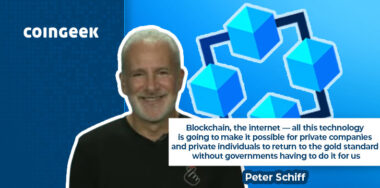Now that the Kleiman v Wright trial is history, its implications are beginning to be understood by the mainstream media. With that, more and more outlets are running stories on it and interviewing people with knowledge of the trial and its facts.
Kitco News host David Lin recently interviewed Kurt Wuckert Jr., CoinGeek’s chief Bitcoin historian, to talk about the trial and what it means for Bitcoin and the world.
Who is Kurt Wuckert Jr?
In case you’re not familiar with Kurt, you should know that he’s been involved in Bitcoin since 2012 and is a passionate advocate for Satoshi’s vision of big blocks and an unbounded Bitcoin protocol.
Kurt attended the trial in Florida in person and was there every day to take notes and give summaries of the proceedings. This gave him first-hand knowledge of what happened and what it means now.
How does Kurt Wuckert Jr. know Dr. Craig Wright?
The first question that the host David Lin asked Kurt was how he knew Dr. Wright. Kurt explained that in 2015, as the Bitcoin scaling war was moving into high gear, he realized he agreed with Dr. Wright’s vision and became a supporter of taking Bitcoin in that direction. He subsequently became acquainted with him at various conferences.
Elaborating on who Dr. Wright is, Kurt mentioned Dr. Wright’s position as Chief Scientist at nChain, his cybersecurity credentials, and why Kurt believes Dr. Wright is Satoshi Nakamoto.
The fundamentals of the Kleiman v Wright case
Next, Kurt was asked to give the viewers a primer on what the Kleiman v Wright case was all about.
He explained how Dave Kleiman had written several white papers with Dr. Wright before he died in 2013. Because the two had partnered on so many white papers and books, Ira Kleiman, the brother of the deceased Dave Kleiman, believed they must have partnered on creating Bitcoin.
However, Dr. Wright disputed this since the outset, claiming that Dave Kleiman acted as an editor for the Bitcoin white paper but that there was no partnership. Ultimately, this is what the jury found, vindicating Dr. Wright and clearing him on counts of fraud, civil theft, breach of partnership, and more.
Is there any evidence that Dr. Wright wrote the Bitcoin white paper?
While it has been decided that Dave Kleiman was not a partner in the creation of Bitcoin, many still wonder whether the evidence proves that Dr. Wright did write the white paper. This was Lin’s next question.
Listing the evidence that was presented in the trial, Kurt informed Lin that:
- We saw sworn testimony from several people, including Dr. Wright’s uncle Donald Lynam who says he saw a rough copy of the white paper before it was released.
- The defense presented notes from Alan Grainger, Dr. Wright’s colleague at BDO, which show Dr. Wright talking about creating and launching a peer-to-peer cash system before Bitcoin was released.
- Gavin Andresen, who was Satoshi Nakamoto’s successor as the lead developer of Bitcoin, also gave sworn testimony that he had seen convincing cryptographic proof when Dr. Wright signed early blocks of his choosing with Satoshi’s private keys.
What is a cryptographic key signing? Kurt briefly covered how the private key signing that Gavin Andresen claims he saw works. To keep it simple, rather than moving coins, the holder of a private key can decode an encrypted message using these keys, thus proving they are the holder of said keys. This is what Andresen claims he saw on two laptops that he was “convinced had not been tampered with.”
Why has Dr. Wright come out fighting for his legacy after releasing Bitcoin anonymously?
Kurt explained that Dr. Wright never wanted to be a public figure. However, around twenty people, including family members and the Australian Taxation Office, knew he was working on Bitcoin.
Later, in 2015, Wired and Gizmodo magazines doxxed Dr. Wright. In this case, it was made apparent that Ira Kleiman and some of Dr. Wright’s disgruntled employees may have been the cause of this leak.
Since he was outed, Dr. Wright has fought vigorously to restore Bitcoin to its original state in the form of BSV. He has spent a substantial amount of time and resources to do so.
How did the court case turn out? What did Dr. Wright win?
Lin asked Kurt to specify what Dr. Wright was being sued for and exactly what he won.
Kurt explained that:
- Dr. Wright was being sued for between $300 and $600 billion in intellectual property, Bitcoin, and potentially punitive damages.
- However, the plaintiff failed to prove that Dave Kleiman was involved in the creation of Bitcoin with Dr. Wright or that there was a formal partnership of any kind between the friends.
But does it prove that Dr. Wright worked on Bitcoin?
Critics claim that while no evidence was presented that Dr. Wright and Dave Kleiman worked on Bitcoin together, there was also no evidence that Dr. Wright worked on it at all.
Kurt noted that some of the evidence he saw at the trial would mean Dr. Wright would have had to start pretending to be Satoshi before Bitcoin was released. This is obviously impossible.
Secondly, Kurt pointed out that the attorneys on both sides evidently thought Dr. Wright has the Satoshi coins. Since the plaintiff’s attorneys rejected settlement offers in multiple rounds of negotiation, and Ira Kleiman was able to procure funding for the lawsuit, clearly, after doing their due diligence, even the plaintiffs concluded that it was worth spending years of time and a vast fortune on pursing Dr. Wright for a share of the massive Bitcoin haul.
Other evidence that Dr. Wright invented Bitcoin includes his educational background and skillset. Kurt pointed out that only a polymath could have created Bitcoin and that Dr. Wright is one of the few people on earth with the background and skill set to pull it off.
Why can’t he just move the coins with the Satoshi keys?
Playing devil’s advocate, Lin asked Kurt the question many people have asked over the years. If Dr. Wright is Satoshi, why go through a court case rather than just publicly prove it cryptographically?
Firstly, Kurt pointed out that it was not Dr. Wright who initiated the lawsuit. He was the defendant in this trial.
Second, Kurt educated the audience on the true ownership of the Satoshi coins. He informed us that Dr. Wright, the legal person, does not own the coins but that various business entities and trusts own them. This was set up this way for various legal and tax reasons.
Third, Kurt pointed out that Dr. Wright has no real interest in proving that he is Satoshi Nakamoto. He has repeatedly stated that he does not owe it to the world to prove it and never wanted to.
Lastly, Kurt mentioned that the coins were under contention until about a week ago. Moving them could have been conversion.
Fast-forward to today, Kurt answered “it would seem so” to the question of whether Dr. Wright now has the right and ability to move coins.
Why does Dr. Wright owe $100 million, and what does it mean?
To this question, Kurt explained there was seven counts in the trial, including fraud, unjust enrichment, breach of partnership, civil theft, etc. He explained that the only one Dr. Wright had lost on was called conversion.
However, Dr. Wright did not lose this to Dave Kleiman’s estate. He lost it to a company in which he and his ex-wife, Lynn Wright, controlled the majority stake. Therefore, Dr. Wright has to personally transfer funds back to a company his family ultimately owns. Potentially, 25% of this sum will go to the estate of Dave Kleiman.
How did Dr. Wright react, and how did he feel?
Since Kurt was with Dr. Wright when the trial ended, Lin asked him how he reacted and felt when it was over.
Kurt said that Dr. Wright visibly looked relieved and excited. He noted that the defense stood up, hugged, shook hands, and otherwise showed signs of celebration.
On the other hand, the plaintiffs look dejected, defeated, and quietly left the courtroom.
What is BSV?
In the final segment of the interview, Lin asked Kurt to talk more about BSV.
Kurt explained that BSV is the original Bitcoin, capable of smart contracts, unbounded scaling, low fees, and much more. He said that “everything you’ve ever heard that was cool about Bitcoin and Ethereum is done better, faster, and cheaper on BSV.”
Kurt also briefly covered some of the potential use cases, including data management and storage as well as payments. Spelling out the implications, he explained that BSV means that other blockchains never needed to be invented at all. He ultimately believes that this is one of the reasons for BSV being delisted by exchanges.
Covering Dr. Wright’s thesis on Bitcoin, Kurt explained that he advocates for a micropayments system that works within the law and wants people to build disruptive businesses. This contrasts with his detractors, such as Coinbase, who sell Bitcoin as an investment asset.
Kurt explained that he believes this ‘investment asset’ thesis sold by Coinbase et al. is a move backward. Fees have increased, countless needless coins have been created, and the exchanges have gotten rich on trading (gambling) fees.
The three possibilities now
To finish the interview, Lin asked Kurt to assign a probability to three potential outcomes:
- Satoshi is dead, to which Kurt explained that several people who helped make Bitcoin work are dead. These include Dave Kleiman, David Rees, and Hal Finney. Therefore, it could be argued that some parts of Satoshi are dead, depending on what you think Satoshi is.
- Satoshi is someone else, to which Kurt answered it would be very strange for him to create something as big as Bitcoin, be so passionate in the early days, and then just walk away, never touching his vast fortune.
- Craig Wright is Satoshi. Kurt pointed out that this is the most likely outcome. He’s seen enough evidence to convince him but believes that the best way to win over almost everyone else is to move Satoshi coins.
Check out all of the CoinGeek special reports on the Kleiman v Wright YouTube playlist.
New to blockchain? Check out CoinGeek’s Blockchain for Beginners section, the ultimate resource guide to learn more about blockchain technology.









